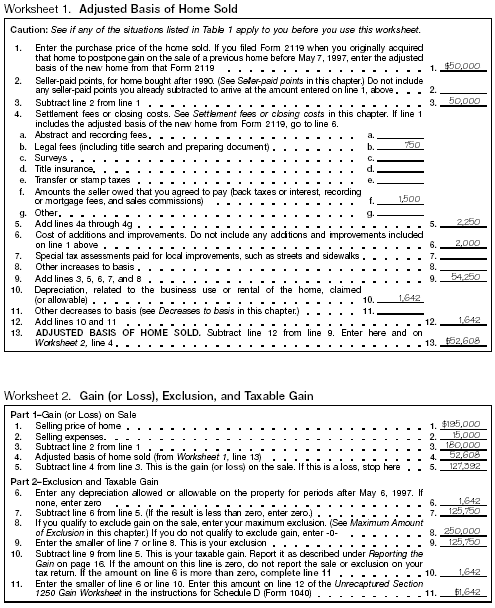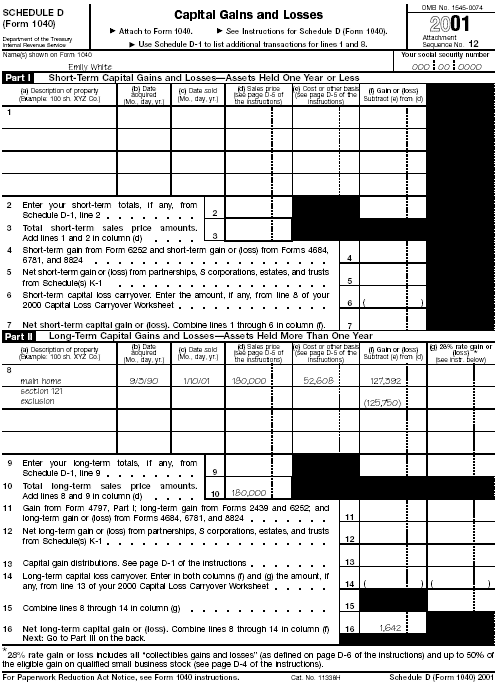Special Situations
The situations that follow may affect your exclusion.
Expatriates. You cannot claim the exclusion if the expatriation tax applies to you. The expatriation tax applies to U.S. citizens who have renounced their citizenship (and long-term residents who have ended their residency) if one of their principal purposes was to avoid U.S. taxes. See chapter 4 of Publication 519, U.S. Tax Guide for Aliens, for more information about expatriation tax.
Home destroyed or condemned. If your home was destroyed or condemned, any gain (for example, because of insurance proceeds you received) qualifies for the exclusion.
Any part of the gain that cannot be excluded (because it is more than the limit) may be postponed under the rules explained in:
- Publication 547, in the case of a home that was destroyed, or
- Chapter 1 of Publication 544, in the case of a home that was condemned.
Sale of remainder interest. Subject to the other rules in this chapter, you can choose to exclude gain from the sale of a remainder interest in your home. If you make this choice, you cannot choose to exclude gain from your sale of any other interest in the home that you sell separately.
Exception for sales to related persons. You cannot exclude gain from the sale of a remainder interest in your home to a related person. Related persons include your brothers and sisters, half-brothers and half-sisters, spouse, ancestors (parents, grandparents, etc.), and lineal descendants (children, grandchildren, etc.). Related persons also include certain corporations, partnerships, trusts, and exempt organizations.
Reporting the Gain
Do not report the 2001 sale of your main home on your tax return unless:
- You have a gain and you do not qualify to exclude all of it, or
- You have a gain and choose not to exclude it.
If you have any taxable gain on the sale of your main home that cannot be excluded, report the entire gain realized (line 5 of Worksheet 2) on Schedule D (Form 1040). Report it on line 1 or line 8 of Schedule D, depending on how long you owned the home. If you qualify for an exclusion (line 9 of Worksheet 2), show it on the line directly below the line on which you report the gain. Write Section 121 exclusion in column (a) of that line and show the amount of the exclusion in column (f) as a loss (in parentheses).
If you used the home for business or to produce rental income during the year of sale, you must use Form 4797 to report the sale of the business or rental part (or the sale of the entire property if used entirely for business or rental in that year). See Business Use or Rental of Home, earlier.
Installment sale. Some sales are made under arrangements that provide for part or all of the selling price to be paid in a later year. These sales are called installment sales. If you finance the buyer's purchase of your home yourself, instead of having the buyer get a loan or mortgage from a bank, you probably have an installment sale. You may be able to report the part of the gain you cannot exclude on the installment basis.
Use Form 6252, Installment Sale Income, to report the sale. Enter your exclusion (line 9 of Worksheet 2) on line 15 of Form 6252.
Seller-financed mortgage. If you sell your home and hold a note, mortgage, or other financial agreement, the payments you receive generally consist of both interest and principal. You must report the interest you receive as part of each payment separately as interest income. If the buyer of your home uses the property as a main or second home, you must also report the name, address, and social security number (SSN) of the buyer on line 1 of either Schedule B (Form 1040) or Schedule 1 (Form 1040A). The buyer must give you his or her SSN and you must give the buyer your SSN. Failure to meet these requirements may result in a $50 penalty for each failure. If you or the buyer does not have and is not eligible to get an SSN, see the next discussion.
Individual taxpayer identification number (ITIN). If either you or the buyer of your home is a nonresident or resident alien who does not have and is not eligible to get an SSN, the IRS will issue you (or the buyer) an ITIN. To apply for an ITIN, file Form W-7, Application for IRS Individual Taxpayer Identification Number, with the IRS.
If you have to include the buyer's SSN on your return and the buyer does not have and cannot get an SSN, enter the buyer's ITIN. If you have to give an SSN to the buyer and you do not have and cannot get one, give the buyer your ITIN.
An ITIN is for tax use only. It does not entitle the holder to social security benefits or change the holder's employment or immigration status under U.S. law.
More information. For more information on installment sales, see Publication 537, Installment Sales.
Illustrated Example
Emily White, a single person, bought a home in 1990. She lived in the home until May 31, 1999, when she moved out of the house and put it up for rent. Emily rented her home until May 31, 2000. She moved back into the house and lived there until she sold it on January 10, 2001.
Emily can exclude gain on the sale of her home because she owned and lived in the home for at least 2 years of the 5-year period ending on the date of the sale.
Emily's records show the following:
| 1) |
Original cost |
$ 50,000 |
| 2) |
Legal fees for title search |
750 |
| 3) |
Back taxes paid for prior owner |
1,500 |
| 4) |
Improvements (deck) |
2,000 |
| 5) |
Selling price |
195,000 |
| 6) |
Commission and expenses of sale |
15,000 |
| 7) |
Depreciation claimed after May 6, 1997 |
1,642 |
Emily uses Worksheet 1 to figure the adjusted basis of the home she sold ($52,608). She uses Worksheet 2 to figure the gain on the sale ($127,392) and the amount of her exclusion ($125,750). Emily cannot exclude $1,642, the part of her gain equal to the depreciation deduction claimed while the house was rented.
Emily reports her gain and exclusion in Part II of Schedule D (Form 1040). She enters $1,642 on line 12 of the Unrecaptured Section 1250 Gain Worksheet in the Schedule D (Form 1040) instructions. She has no gains or losses from the sale of property other than the gain from the sale of her home so, after completing that worksheet, she also enters $1,642 on line 19 of Schedule D. She then figures her tax using Part IV of Schedule D.
Emily's completed Worksheets 1 and 2 and the front page of her Schedule D appear on pages 18 and 19. Page 2 of Schedule D and her Unrecaptured Section 1250 Gain Worksheet are not shown.

worksheets for Emily White

Schedule D for Emily White
Real Estate and Transfer Taxes
When you sell your main home, treat real estate and transfer taxes on that home as discussed in this section.
Real estate taxes. You and the buyer must deduct the real estate taxes on your home for the year of sale according to the number of days in the real property tax year that each owned the home.
- You are treated as paying the taxes up to, but not including, the date of sale. You can deduct these taxes as an itemized deduction on Schedule A (Form 1040) in the year of sale. It does not matter what part of the taxes you actually paid.
- The buyer is treated as paying the taxes beginning with the date of sale.
If the buyer paid your share of the taxes (or any delinquent taxes you owed), the payment increases the selling price of your home. The buyer adds the amount paid to his or her basis in the property.
Example. The tax on Dennis and Beth White's home was $620 for the year. Their real property tax year was the calendar year, with payment due August 1. They sold the home on May 7. Dennis and Beth are considered to have paid a proportionate share of the real estate taxes on the home even though they did not actually pay them to the taxing authority.
Dennis and Beth owned their home during the real property tax year for 126 days (January 1 to May 6, the day before the sale). They figure their deduction for taxes as follows.
| 1. |
Enter the total real estate taxes for the real property tax year |
$620 |
| 2. |
Enter the number of days in the real property tax year that you owned the property |
126 |
| 3. |
Divide line 2 by 365 |
.345 |
| 4. |
Multiply line 1 by line 3. This is your deduction. Enter it on line 6 of Schedule A (Form 1040) |
$214 |
Since the buyers paid all the taxes, Dennis and Beth also include the $214 in the home's selling price. The buyers add the $214 to their basis in the home. The buyers can deduct $406 ($620 - $214), the taxes for the part of the year they owned the home.
Form 1099-S. If the person responsible for closing the sale (generally the settlement agent) must file Form 1099-S, the information reported on the form to you and the IRS must include (in box 5) the part of any real estate tax that the buyer can deduct. If you actually paid the taxes for the year of sale, you must subtract the amount shown in box 5 of Form 1099-S from the amount you paid. The result is the amount you can deduct.
More information. For more information about real estate taxes, see Publication 530.
Transfer taxes. You cannot deduct transfer taxes, stamp taxes, and other incidental taxes and charges on the sale of a home as itemized deductions. However, if you pay these amounts as the seller of the property, they are expenses of the sale and reduce the amount you realize on the sale. If you pay these amounts as the buyer, include them in your cost basis of the property.
Previous | First | Next
Publication Index | 2002 Tax Help Archives | Tax Help Archives | Home
